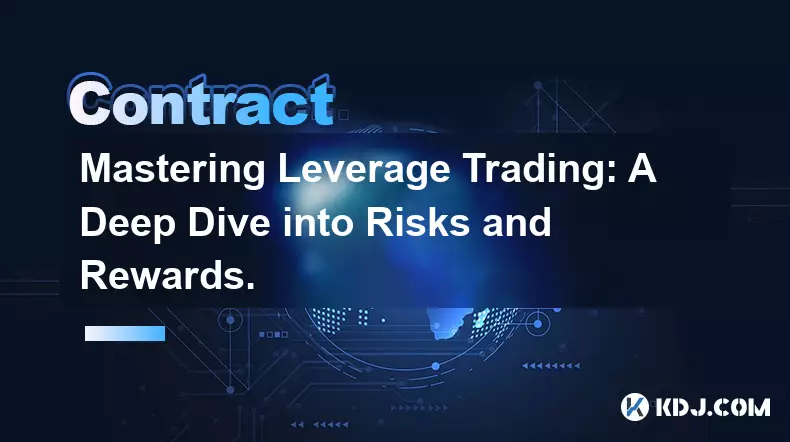-
 bitcoin
bitcoin $105968.894684 USD
4.17% -
 ethereum
ethereum $3639.320047 USD
7.62% -
 tether
tether $1.000339 USD
0.06% -
 xrp
xrp $2.407774 USD
5.96% -
 bnb
bnb $1011.704193 USD
2.28% -
 solana
solana $166.942754 USD
6.37% -
 usd-coin
usd-coin $1.000143 USD
0.03% -
 tron
tron $0.291515 USD
0.25% -
 dogecoin
dogecoin $0.181682 USD
4.06% -
 cardano
cardano $0.585450 USD
4.54% -
 hyperliquid
hyperliquid $42.099968 USD
5.20% -
 chainlink
chainlink $16.160745 USD
5.45% -
 zcash
zcash $645.269648 USD
12.96% -
 bitcoin-cash
bitcoin-cash $507.430338 USD
2.80% -
 stellar
stellar $0.290357 USD
3.69%
Mastering Leverage Trading: A Deep Dive into Risks and Rewards.
Leverage in crypto amplifies both gains and losses, with high volatility and liquidation risks demanding disciplined risk management and realistic position sizing.
Nov 04, 2025 at 12:18 pm

Understanding Leverage in Crypto Trading
1. Leverage allows traders to control a larger position using a fraction of the capital required for a full spot trade. In the crypto market, platforms often offer leverage ratios ranging from 2x up to 100x, depending on the asset and exchange. This means that with $1,000 and 10x leverage, a trader can open a position worth $10,000.
2. The amplified exposure increases both profit potential and loss severity. A small price movement in favor of the position can yield substantial returns relative to the initial margin. However, the same sensitivity works against the trader when the market moves unfavorably.
3. Margin is the collateral deposited to maintain a leveraged position. Exchanges require a minimum maintenance margin; if losses reduce equity below this threshold, a margin call or automatic liquidation may occur. Liquidation wipes out the trader’s margin, turning the position into a total loss.
4. Different cryptocurrencies exhibit varying volatility levels, which directly affects the risk profile of leveraged trades. Highly volatile assets like meme coins can trigger liquidations within minutes during sharp swings, even at moderate leverage levels.
5. Funding rates are another critical aspect in perpetual futures contracts, commonly used in leveraged trading. Traders either pay or receive funding every few hours based on the difference between futures and spot prices. Over time, these costs accumulate and erode profits, especially in sideways markets.
Risks Associated with High Leverage
1. Market volatility in cryptocurrency is extreme compared to traditional financial markets. Sudden news events, whale movements, or exchange outages can cause rapid price dislocations. At high leverage, such movements can lead to immediate liquidation before a trader has time to react.
2. Emotional decision-making intensifies under leveraged conditions. The pressure of watching large notional positions shift dramatically can prompt impulsive actions like panic closing or revenge trading. These behaviors often result in compounding losses.
3. Counterparty risk exists on centralized exchanges offering leverage. If an exchange faces technical failure, insolvency, or regulatory shutdown, open positions may be frozen or settled unfairly. Historical precedents show user funds lost during exchange collapses, particularly during bear markets.
4. Slippage becomes more dangerous with large leveraged orders. During periods of low liquidity, stop-loss and take-profit orders may execute at significantly worse prices than expected. This discrepancy can turn a calculated risk into an outsized loss.
5. Over-leveraging is one of the most common mistakes. New traders often assume that higher leverage equals faster wealth accumulation. In reality, accounts using 50x or 100x leverage typically face liquidation within days due to inadequate risk management and unrealistic position sizing.
Strategies to Maximize Rewards Safely
1. Position sizing should align with account risk tolerance. A widely accepted rule is to risk no more than 1% to 2% of total capital per trade. For example, on a $10,000 account, the maximum loss per trade should not exceed $100–$200, regardless of leverage applied.
2. Use of stop-loss orders is essential in managing downside exposure. Placing a stop-loss at a technically valid level helps limit losses and prevents emotional interference. Some traders combine stop-losses with hedging strategies using options or inverse positions.
3. Scaling in and out of positions reduces timing risk. Instead of entering a full leveraged position at once, traders can deploy capital in increments based on price confirmation. This method improves average entry points and lowers vulnerability to short-term noise.
4. Monitoring open interest and liquidation heatmaps provides insight into market structure. Areas with high concentrations of long or short liquidations often act as magnets for price, creating short-term reversal opportunities for informed traders.
5. Maintaining a trading journal enhances discipline and performance over time. Recording each leveraged trade with rationale, entry/exit logic, and outcome helps identify patterns, refine strategy, and avoid repeating costly errors.
Common Misconceptions About Leverage
1. Many believe leverage multiplies only profits. In truth, it amplifies outcomes both positively and negatively. A 5% drop in price can erase a 50% account balance at 10x leverage if the entire portfolio is exposed.
2. There is a false assumption that experienced traders always use high leverage. Top-performing traders often operate at 2x to 5x leverage, prioritizing capital preservation over aggressive gains.
3. Some think automated trading bots eliminate leverage risk. While bots can enforce rules, they cannot predict black swan events or adapt instantly to structural market changes. Poorly configured bots can accelerate losses during flash crashes.
4. Leverage does not increase the probability of winning a trade. It only changes the payoff ratio. Success depends on accurate market analysis, timing, and execution—not the size of the position.
Frequently Asked Questions
What happens when a leveraged position gets liquidated?When a leveraged position breaches the maintenance margin requirement, the exchange automatically closes it to prevent further losses. The trader loses the margin allocated to that trade, and any remaining value—if applicable—is returned, though often minimal or zero in deep liquidations.
Can I trade with leverage on decentralized exchanges?Yes, several DeFi protocols now support leveraged trading through synthetic assets or peer-to-pool margin systems. Examples include Synthetix, dYdX, and Kwenta. These platforms use smart contracts instead of centralized order books, offering censorship resistance but sometimes lower liquidity.
How do I choose the right leverage level?Assess the asset’s volatility, your risk tolerance, and the precision of your entry. For stablecoins or low-volatility pairs, 5x to 10x may be manageable. For altcoins, sticking to 2x to 5x is safer. Never base leverage on greed—always on statistical edge and proven strategy.
Are there alternatives to high-leverage trading for amplifying returns?Yes. Compounding gains through consistent low-risk trades, yield farming with hedged positions, or using structured products like range-tokens can generate strong returns without exposing capital to liquidation risks inherent in high leverage.
Disclaimer:info@kdj.com
The information provided is not trading advice. kdj.com does not assume any responsibility for any investments made based on the information provided in this article. Cryptocurrencies are highly volatile and it is highly recommended that you invest with caution after thorough research!
If you believe that the content used on this website infringes your copyright, please contact us immediately (info@kdj.com) and we will delete it promptly.
- XRP Primed for a Major Leg-Up? Technical Analysts Weigh In
- 2025-11-11 00:30:02
- Bitcoin Price, JPMorgan, and the Crypto Moves You Need to Know
- 2025-11-10 22:50:02
- XRP ETFs in 2026: Will They Reshape the Crypto Landscape?
- 2025-11-10 22:50:02
- Decred Price Prediction: Navigating the Bull Market Buzz
- 2025-11-10 23:05:01
- Brett Coin, Crypto Presale, 1000X Prediction: What's the Hype?
- 2025-11-10 23:05:01
- Starknet (STRK) Price Surges: Decoding the Reasons Behind the Pump
- 2025-11-10 23:15:01
Related knowledge

What is a Denial of Service (DoS) attack in a smart contract and what are its common forms?
Nov 10,2025 at 05:20am
Understanding Denial of Service in Smart Contracts1. A Denial of Service (DoS) attack in the context of smart contracts refers to a scenario where a m...

How do you safely send Ether to another contract?
Nov 09,2025 at 06:40pm
Sending Ether to Smart Contracts: Key Considerations1. Verify that the receiving contract has a payable fallback function or a designated payable func...

What is a state machine and how can a contract be designed as one?
Nov 08,2025 at 02:19pm
Understanding State Machines in Blockchain Context1. A state machine is a computational model used to design systems that transition between defined s...

How does a bonding curve work and how is it used for token sales?
Nov 09,2025 at 04:00pm
Understanding the Mechanics of Bonding Curves1. A bonding curve is a mathematical function that links the price of a token to its supply. As more toke...

What is a mapping in Solidity and how does it store key-value pairs?
Nov 10,2025 at 12:20pm
Understanding Mappings in Solidity1. A mapping in Solidity is a reference type used to store data in the form of key-value pairs, similar to hash tabl...

How do you upgrade a smart contract using the UUPS proxy pattern?
Nov 09,2025 at 01:19am
Understanding the UUPS Proxy Pattern in Smart Contract DevelopmentThe UUPS (Universal Upgradeable Proxy Standard) pattern has become a cornerstone in ...

What is a Denial of Service (DoS) attack in a smart contract and what are its common forms?
Nov 10,2025 at 05:20am
Understanding Denial of Service in Smart Contracts1. A Denial of Service (DoS) attack in the context of smart contracts refers to a scenario where a m...

How do you safely send Ether to another contract?
Nov 09,2025 at 06:40pm
Sending Ether to Smart Contracts: Key Considerations1. Verify that the receiving contract has a payable fallback function or a designated payable func...

What is a state machine and how can a contract be designed as one?
Nov 08,2025 at 02:19pm
Understanding State Machines in Blockchain Context1. A state machine is a computational model used to design systems that transition between defined s...

How does a bonding curve work and how is it used for token sales?
Nov 09,2025 at 04:00pm
Understanding the Mechanics of Bonding Curves1. A bonding curve is a mathematical function that links the price of a token to its supply. As more toke...

What is a mapping in Solidity and how does it store key-value pairs?
Nov 10,2025 at 12:20pm
Understanding Mappings in Solidity1. A mapping in Solidity is a reference type used to store data in the form of key-value pairs, similar to hash tabl...

How do you upgrade a smart contract using the UUPS proxy pattern?
Nov 09,2025 at 01:19am
Understanding the UUPS Proxy Pattern in Smart Contract DevelopmentThe UUPS (Universal Upgradeable Proxy Standard) pattern has become a cornerstone in ...
See all articles























![🔥 Long awaited! The ancestor of Pi coin is about to take off? PI friends, come in and take a look! [Daily Coin Selection | Bitcoin Trend | Money Making Opportunities] 🔥 Long awaited! The ancestor of Pi coin is about to take off? PI friends, come in and take a look! [Daily Coin Selection | Bitcoin Trend | Money Making Opportunities]](/uploads/2025/11/10/cryptocurrencies-news/videos/6911e42f9bad7_image_500_375.webp)


















































